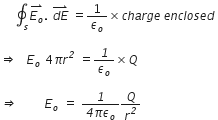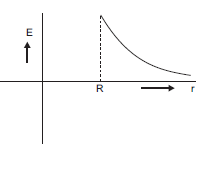Using Gauss's law obtains the expression for the electric field due to a uniformly charged thin spherical shell of radius R at a point outside the shell. Draw a graph showing the variation of electric field with r, for r > R and r < R.
Electric field intensity at a point outside a uniformly charged thin spherical shell:
Consider a uniformly charged thin spherical shell of radius R carrying charge Q. Let us assume a spherical Gaussian surface of radius r (>R), concentric with the given shell inorder to find the electric field outside the shell.
If is the electric field outside the shell, then by symmetry electric field strength has same magnitude Eo on the Gaussian surface and is directed radially outward. Also, the direction of normal at each point is radially outward. So, angle between ![]()
Therefore, electric flux through Gaussian surface, ![]()

Now, charge enclosed by the Gaussian surface is Q [Gaussian surface is outside the given charged shell].
Therefore, using Gauss theorem, 
This is the required electric field outside a given thin charged shell.
If ![]() is the surface charge density of the spherical shell, then
is the surface charge density of the spherical shell, then

Electric field inside the shell:
If is the electric field inside the shell, then by symmetry electric field strength has the same magnitude Ei on the Gaussian surface and is directed radially outward. Also the directions of normal at each point are radially outward. So angle between Ei and is zero at each point.
Thus, electric flux through Gaussian surface is 0 because of the absence of the charge.
The below graph shows the variation of electric field with r, for r >R and r < R.
